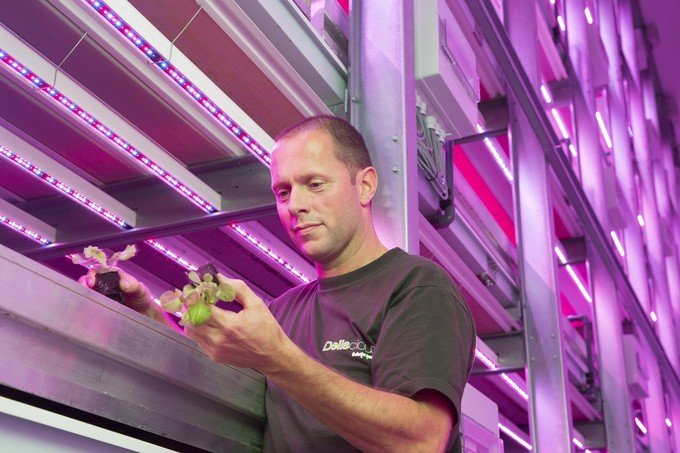
The World Health Organisation estimates that by 2030, 60% of the global population will live in cities, up from 20% a century ago.
Add to this our contemporary paradoxical expectations on food – that produce be plentiful, local and yet should be available, in all its variation, year-round.
So, as cities get bigger, taking the land that used to be farmed and turning it into houses, shops, apartments, offices and factories, how do we continue to feed these these growing urban populations? How can we best make use of space, when space is becoming such a scarce resource? How can we grow food, indoors, that’s healthy and efficient?
By stripping horticulture back to its essentials of light and water, Philips think’s it’s found the answer: LED lights that can be programmed to transmit different types of light depending on the plant being grown.

Use of artificial light to grow plants is not new. Green houses and hydroponics have been used for decades to shorten growing time and extend seasons. But traditional broad-spectrum lights that have been used in plant growth – typically high-pressure sodium lamps – were developed not to grow plants but to illuminate space, so are tuned to the human eye. They’re blunt instruments, generating light which is not needed by the plant and heat which requires the lights to be further away from the plants.
Of course, a plant’s sensitivity to light is very different to a human’s. Light contains a number of different colours, which are determined by the wavelength of the light, from infrared (which has a very long wavelength) to ultraviolet (which has a very short wavelength). A plant’s photosynthetic process only uses certain wavelengths, some of which are non-visible, and different plants respond to different wavelengths.
LEDs are highly-efficient, low heat, and can produce light in very specific colours with specific wavelengths, from far infrared to ultraviolet. So by giving a plant only the wavelengths that it needs to grow, there’s no wasted light. Also, because LEDs are cool, they can be placed very close to the plants, reducing wasted light.
“LED’s have huge potential for horticulture,” says Udo van Slooten, director of Philips Horticultural Lighting. “They deliver almost complete freedom of choice which allows us to optimise lighting solutions to bring even greater value for growers – whether that is higher wields, lower running costs or more control over when plants are ready to go to market.”
To help best make use of this technology, Philips has collaborated with plant growers to develop ‘light recipes’ for various plants, combining certain wavelengths, from certain distances, that are used in combination with an accordant set of nutrients, and water levels.
The result is crops that are grown faster, using less power and water, that are less at risk to disease or contamination (negating the need to for the pesticides that are often used outdoors).
Philips are currently only making horticultural lights for large-scale use, but sees potential in developing smaller systems with built-in irrigation that could be used in offices, schools, and at home.
So, in the near-future, a locally sourced meal might not mean that it was grown on a farm an hour out of town, it could mean that it was grown in the basement, or two floors above. Your home garden might mean a wall of purple lights rather than a few pots of shriveling basel plants on the deck.




